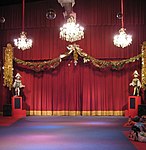Mary Andrews Clark Memorial Home

Mary Andrews Clark Memorial Home is a four-story, 76,000-square-foot (7,100 m2) "French Revival Chateauesque" brick structure in the Westlake neighborhood of Los Angeles near downtown. It was built in 1913 as a YWCA home for young working women. The house was built by William A. Clark (1839–1925), the copper magnate after whom Clark County, Nevada, was named, as a memorial to his mother Mary Andrews Clark (1814–1904). The home was operated by the YWCA from 1913 to 1987, when it was closed as a result of damage sustained in the Whittier Narrows earthquake. The building reopened in 1995 as housing for low income single workers. The building has been designated a Los Angeles Historic-Cultural Monument, and is listed on the National Register of Historic Places.
Excerpt from the Wikipedia article Mary Andrews Clark Memorial Home (License: CC BY-SA 3.0, Authors, Images).Mary Andrews Clark Memorial Home
Columbia Avenue, Los Angeles Westlake
Geographical coordinates (GPS) Address Nearby Places Show on map
Geographical coordinates (GPS)
| Latitude | Longitude |
|---|---|
| N 34.06 ° | E -118.26416666667 ° |
Address
Columbia Avenue 275
90026 Los Angeles, Westlake
California, United States
Open on Google Maps






